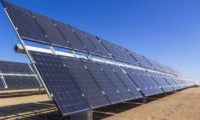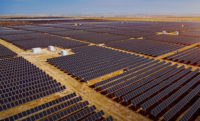Long running tariff disputes between U.S.-based solar energy project builders and domestic component manufacturers over cheaper Chinese imports came to a head this month on two fronts. A federal court agreed with developers that duties on certain solar panels are not legal, and the U.S. Commerce Dept. declined to rule on an anti-dumping complaint from three anonymous American producers.
U.S. Court of International Trade Judge Gary Katzmann ruled Nov. 16 that the Trump Administration illegally modified its trade restrictions on solar panels to retroactively include two-sided “bifacial” solar panels.
The administration “clearly misconstrued” the reach of the federal Trade Act and acted outside the President’s authority, the judge said. The law does not allow the President to increase restrictions on trade by withdrawing “an exclusion from safeguard duties” unless certain conditions are met.
President Donald Trump in early 2018 imposed a tariff on certain imported solar panels, excluding bifacial panels from that penalty. The bifacial panels can produce power from both sides of the unit, but were excluded because they were not considered a threat to U.S. manufacturers. They are now used more often by solar developers to boost power output.
His administration withdrew the bifacial panel exclusion in 2020, increasing the tariffs on solar panel imports generally to 18% from 15%.
Lifting the exclusion on bifacial solar panels and boosting duties on crystalline silicon photovoltaic cell modules was beyond a President's "delegated authority,” Katzmann said, noting that the law permits “only trade-liberalizing modifications to existing safeguard measures.”
The government can no longer enforce the tariff on bifacial panels and must refund all duties collected with interest to plaintiffs that include the Solar Energy Industries Association, Nextera Energy, Invenergy Renewables and EDF Renewables.
Katzmann reiterated his decision on the panel tariff in a separate challenge by developers against the US. trade representative, ruling on Nov. 17 that “the exclusion ... must be vacated for lack of statutory authority and as arbitrary and capricious.”
Biden Administration attorneys had recently argued in favor of the Trump tariffs, claiming they attempted to close a "loophole" that undermined protections against booming imports. It can appeal the ruling but has not indicated whether it will.
Abigale Ross Hopper, CEO of the Solar Energy Industries Association, agreed with the court’s decision.
She said the group will champion the Solar Energy Manufacturing for America Act introduced in September that would provide credits for American manufacturers at every stage of the solar component supply chain, adding that the pending Build Back Better Act also has provisions to boost U.S. production.
But American manufacturers reached by ENR remain concerned. There are 17 in the U.S., says industry publication Solar Power World.
Among the largest is Hanwha Q Cells, a Korean manufacturer that has a production plant in Georgia, and First Solar, which operates in Ohio. “This is an unfortunate ruling that puts domestic solar manufacturers at risk of immediate and substantial harm,” says a spokesperson for Hanwha Q Cells.
“This exclusion never should have existed in the first place," adds Mamun Rachid, CEO of California-based solar component maker Auxin Solar. "We hope that the government will appeal this erroneous decision.”
Also a setback for the U.S. industry was the Commerce Dept.'s Nov. 10 decision to reject a petition by several unidentified producers to find that China was circumventing the antidumping duty on photovoltaic cells by having them completed by companies in Malaysia, Thailand and Vietnam before being shipped to the U.S.
The manufacturers claimed that the anonymity was necessary due to potential retaliation from certain Chinese companies and government entities.
The department reviewed the companies’ support for their claim of retaliation and found it “unconvincing.” Commerce said not disclosing company names “publicly hampers interested parties from fully commenting on the requests for circumvention inquiries and could be be a limiting factor if the government pursued a trade action.
Commerce also noted that there is a history of China shifting the production of solar cells to other countries and that it could consider a country-by-country complaint rather than the company-specific request submitted by the U.S. manufacturers.
In a statement, the manufacturers said that while U.S. sector economics are improving, “we should not have to compete with the unfair trade practices of China and Chinese-owned companies.”
The U.S. Energy Dept. said in its Nov. 16 short term energy outlook that solar energy will account for 4% of U.S. generation in 2021 and 5% in 2022, projecting it will make up 14% of the total in 2035 and 20% in 2050. The generation is from both utility-scale capacity of more than 1 MW and small-scale solar facilities in the electric power, residential, commercial, and industrial sectors, the agency said.






Post a comment to this article
Report Abusive Comment